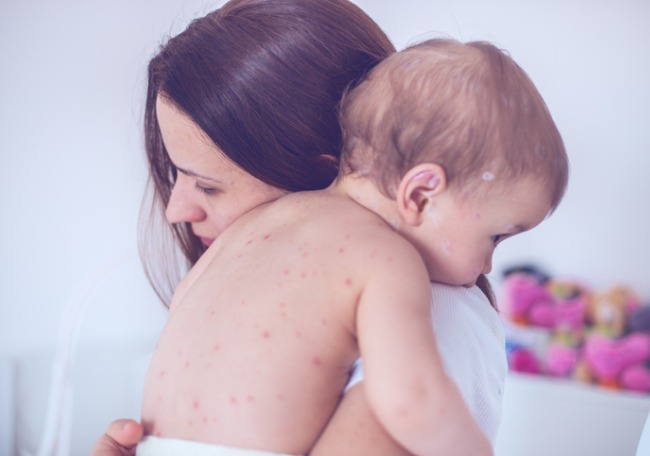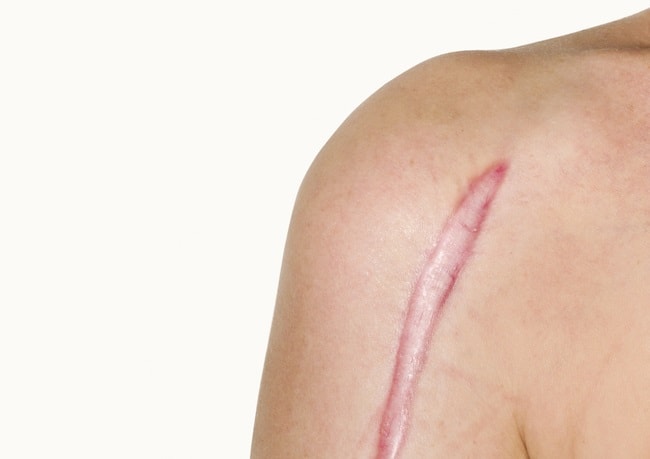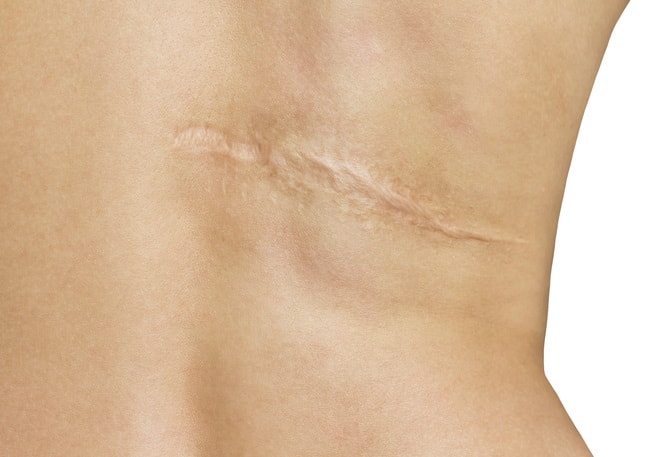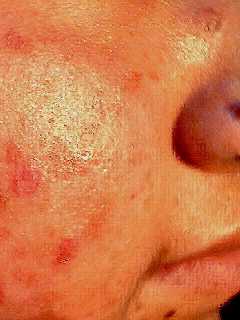Manejo de cicatrices en pediatría
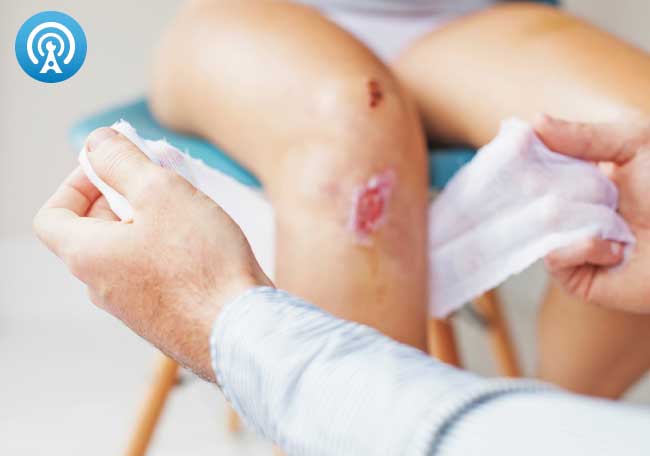
1. English RS, Shenefelt PD. Keloids and hypertrophic scars. Dermatol Surg. 1999; 25(8):631–638
2. Seifert O, Mrowietz U. Keloid scarring: bench and bedside. Arch Dermatol Res. 2009; 301(4):259–272
3. Sund B. New Developments in Wound Care. London, UK: PJB Publications; 2000
4. Meuli M, Lochbühler H. Current concepts in pediatric burn care: general management of severe burns. Eur J Pediatr Surg. 1992; 2(4):195–200
5. Midwood KS, Williams LV, Schwarzbauer JE. Tissue repair and the dynamics of the extracellular
matrix. Int J Biochem Cell Biol. 2004; 36(6):1031–1037
6. Marneros AG, Norris JE, Olsen BR, Reichenberger E. Clinical genetics of familial keloids. Arch Dermatol. 2001; 137(11):1429–1434
7. Bayat A, Arscott G, Ollier WE, McGrouther DA, Ferguson MW. Keloid disease: clinical relevance of single versus multiple site scars. Br J Plast Surg. 2005; 58(1):28–37
8. Tirgan MH, Shutty CM, Park TH. Nine-month-old patient with bilateral earlobe keloids. Pediatrics. 2013; 131(1). Available at: www.pediatrics. Org/chi/ content/full/131/ 1/e313
9. Lee JY, Yang CC, Chao SC, Wong TW. Histopathological differential diagnosis of keloid and hypertrophic scar. Am J Dermatopathol. 2004; 26(5):379–384
10. Arno AI, Gauglitz GG, Barret JP, Jeschke MG. Up-to-date approach to manage keloids and hypertrophic scars: a useful guide. Burns. 2014; 40(7):1255–1266
11. Gauglitz GG, Korting HC, Pavicic T, Ruzicka T, Jeschke MG. Hypertrophic scarring and keloids:
pathomechanisms and current and emerging treatment strategies. Mol Med. 2011; 17(1–2):113–125
12. Lane JE, Waller JL, Davis LS. Relationship between age of ear piercing and keloid formation.
Pediatrics. 2005; 115(5):1312–1314
13. Love PB, Kundu RV. Keloids: an update on medical and surgical treatments. J Drugs Dermatol. 2013; 12(4):403–409
14. van der Wal MB, Verhaegen PD, Middelkoop E, van Zuijlen PP. A clinimetric overview of scar
Assessment scales. J Burn Care Res. 2012; 33(2):e79–e87
15. Rumsey N, Clarke A, White P. Exploring the psychosocial concerns of outpatients with disfiguring conditions. J Wound Care. 2003; 12(7):247–252
16. van Leersum NJ, van Leersum RL, Verwey HF, Klautz RJ. Pain symptoms accompanying chronic poststernotomy pain: a pilot study. Pain Med. 2010; 11(11):1628–1634
17. Zhu J, Cheng B, Liu H, Tang J, Xiang X, Peng Y. Expression of betaendorphin in hypertrophic scar and its relationship with pruritus [in Chinese]. Zhongguo Xiu Fu Chong Jian Wai Ke Za Zhi. 2012; 26(6):731–734
18. Lee SS, Yosipovitch G, Chan YH, Goh CL. Pruritus, pain, and small nerve fiber function in keloids: a controlled study. J Am Acad Dermatol. 2004; 51(6):1002–1006
19. Gupta S, Gupta S, Kanwar AJ, Kumar B. Hypertrichosis surrounding scar of knee replacement surgery. J Am Acad Dermatol. 2004; 50(5):802–803
20. Akoglu G, Emre S, Metin A, Bozkurt M. High frequency of hypertrichosis after cast application. Dermatology. 2012; 225(1):70–74
21. Hamilton N, Weimar W, Luttgens KH. Kinesiology: Scientifi c Basis of Human Motion. 9th ed. Madison, WI: Brown & Benchmark; 1997
22. Goel A, Shrivastava P. Post-burn scars and scar contractures. Indian J Plast Surg. 2010; 43(suppl):S63–S71
23. Bolognia J, Jorizzo JL, Rapini RP. Dermatology. 2nd ed. St Louis, MO: Mosby/Elsevier; 2008
24. Nguyen TA, Feldstein SI, Shumaker PR, Krakowski AC. A review of scar assessment scales. Semin Cutan Med Surg. 2015; 34(1):28–36
25. Brown BC, Moss TP, McGrouther DA, Bayat A. Skin scar preconceptions must be challenged: importance of self-perception in skin scarring. J Plast Reconstr Aesthet Surg. 2010; 63(6):1022–1029
26. Gilboa D, Bisk L, Montag I, Tsur H. Personality traits and psychosocial adjustment of patients with burns. J Burn Care Rehabil. 1999; 20(4):340–346, discussion 338–339
27. Lawrence JW, Mason ST, Schomer K, Klein MB. Epidemiology and impact of scarring after burn injury: a systematic review of the literature. J Burn Care Res. 2012; 33(1):136–146
28. Langeland W, Olff M. Psychobiology of posttraumatic stress disorder in pediatric injury patients: a review of the literature. Neurosci Biobehav Rev. 2008; 32(1):161–174
29. Stoddard FJ, Norman DK, Murphy JM. A diagnostic outcome study of children and adolescents with severe burns. J Trauma. 1989; 29(4):471–477
30. Jacob CI, Dover JS, Kaminer MS. Acne scarring: a classifi cation system and review of treatment options. J Am Acad Dermatol. 2001; 45(1):109–117
31. Gold MH, Berman B, Clementoni MT, Gauglitz GG, Nahai F, Murcia C. Updated international clinical recommendations on scar management: part 1—evaluating the evidence. Dermatol Surg. 2014; 40(8):817–824
32. Gold MH, McGuire M, Mustoe TA, et al; International Advisory Panel on Scar Management. Updated international clinical recommendations on scar management: part 2--algorithms for scar prevention and treatment. Dermatol Surg. 2014; 40(8):825–831
33. Slemp AE, Kirschner RE. Keloids and scars: a review of keloids and scars, their pathogenesis, risk factors, and management. Curr Opin Pediatr. 2006; 18(4):396–402
34. Liotta DR, Costantino PD, Hiltzik DH. Revising large scars. Facial Plast Surg. 2012; 28(5):492–496
35. Admani S, Gertner JW, Grosman A, Shumaker PR, Uebelhoer NS, Krakowski AC. Multidisciplinary, multimodal approach for a child with a traumatic facial scar. Semin Cutan Med Surg. 2015; 34(1):24–27
36. Mathes EF, Haggstrom AN, Dowd C, Hoffman WY, Frieden IJ. Clinical characteristics and management of vascular anomalies: findings of a multidisciplinary vascular anomalies clinic. Arch Dermatol. 2004; 140(8):979–983
37. Robin NH, Baty H, Franklin J, et al. The multidisciplinary evaluation and management of cleft lip and palate. South Med J. 2006; 99(10):1111–1120 38. Warden GD, Brinkerhoff C, Castellani D, Rieg LS. Multidisciplinary team approach to the pediatric burn patient. QRB Qual Rev Bull. 1988; 14(7):219–226
39. Robles DT, Berg D. Abnormal wound healing: keloids. Clin Dermatol. 2007; 25(1):26–32
40. Hamrick M, Boswell W, Carney D. Successful treatment of earlobe keloids in the pediatric population. J Pediatr Surg. 2009; 44(1):286–288
41. Krusche T, Worret WI. Mechanical properties of keloids in vivo during treatment with intralesional triamcinolone acetonide. Arch Dermatol Res. 1995; 287(3–4):289–293
42. Ledon JA, Savas J, Franca K, Chacon A, Nouri K. Intralesional treatment for keloids and hypertrophic scars: a review. Dermatol Surg. 2013; 39(12):1745–1757
43. Muneuchi G, Suzuki S, Onodera M, Ito O, Hata Y, Igawa HH. Long-term outcome of intralesional injection of triamcinolone acetonide for the treatment of keloid scars in Asian patients. Scand J Plast Reconstr Surg Hand Surg. 2006; 40(2):111–116
44. Chuang GS, Rogers GS, Zeltser R. Poiseuille’s law and large-bore needles: insights into the delivery of corticosteroid injections in the treatment of keloids. J Am Acad Dermatol. 2008; 59(1):167–168
45. Tosa M, Murakami M, Hyakusoku H. Effect of lidocaine tape on pain during intralesional injection of triamcinolone acetonide for the treatment of keloid. J Nippon Med Sch. 2009; 76(1):9–12
46. RxList. Kenalog 10 injection. Available at: http:// www. rxlist. com/kenalog- 10- injection- drug/ indications- dosage. htm. Accessed April 3, 2014
47. Benkhaial GS, Cheng KM, Shah RM. Effects of 5-fl uorouracil on collagen synthesis during quail secondary palate development. J Craniofac Genet Dev Biol. 1993; 13(1):6–17
48. Ben-Khaial GS, Shah RM. Effects of 5-fl uorouracil on collagen synthesis in the developing palate of hamster. Anticancer Drugs. 1994; 5(1):99–104
49. Bulstrode NW, Mudera V, McGrouther DA, Grobbelaar AO, Cambrey AD. 5-fl uorouracil selectively inhibits collagen synthesis. Plast Reconstr Surg2005116 (1):209–221; discussion 222–223
50. Fitzpatrick RE. Treatment of inflamed hypertrophic scars using intralesional 5-FU. Dermatol Surg. 1999; 25(3):224–232
51. Uppal RS, Khan U, Kakar S, Talas G, Chapman P, McGrouther AD. The effects of a single dose of 5-fl uorouracil on keloid scars: a clinical trial of timed wound irrigation after extralesional excision. Plast Reconstr Surg. 2001; 108(5):1218–1224
52. Gupta S, Kalra A. Efficacy and safety of intralesional 5-fl uorouracil in the treatment of keloids. Dermatology. 2002; 204(2):130–132
53. Sadeghinia A, Sadeghinia S. Comparison of the efficacy of intralesional triamcinolone acetonide and 5-fl uorouracil tattooing for the treatment of keloids. Dermatol Surg. 2012; 38(1):104–109
54. de Oliveira WR, Festa Neto C, Rady PL, Tyring SK. Clinical aspects of epidermodysplasia verruciformis. J Eur Acad Dermatol Venereol. 2003; 17(4):394–398
55. Klinger M, Caviggioli F, Klinger FM, et al. Autologous fat graft in scar treatment. J Craniofac Surg. 2013; 24(5):1610–1615
56. Guibert M, Franchi G, Ansari E, et al. Fat graft transfer in children’s facial malformations: a prospective three-dimensional evaluation. J Plast Reconstr Aesthet Surg. 2013; 66(6):799–804
57. Sultan SM, Barr JS, Butala P, et al. Fat grafting accelerates revascularisation and decreases fi brosis following thermal injury. J Plast Reconstr Aesthet Surg. 2012; 65(2):219–227
58. Pallua N, Baroncini A, Alharbi Z, Stromps JP. Improvement of facial scar appearance and microcirculation by autologous lipofilling. J Plast Reconstr Aesthet Surg. 2014; 67(8):1033–1037
59. Cervelli V, Nicoli F, Spallone D, et al. Treatment of traumatic scars using fat grafts mixed with platelet-rich plasma, and resurfacing of skin with the 1540 nm nonablative laser. Clin Exp Dermatol. 2012; 37(1):55–61
60. Berman B, Bieley HC. Adjunct therapies to surgical management of keloids. Dermatol Surg. 1996; 22(2):126–130
61. Darzi MA, Chowdri NA, Kaul SK, Khan M. Evaluation of various methods of treating keloids and hypertrophic scars: a 10-year follow-up study. Br J Plast Surg. 1992; 45(5):374–379
62. Lawrence WT. In search of the optimal treatment of keloids: report of a series and a review of the literature. Ann Plast Surg. 1991; 27(2):164–178
63. Music EN, Engel G. Earlobe keloids: a novel and elegant surgical approach. Dermatol Surg. 2010; 36(3):395–400
64. Rosen DJ, Patel MK, Freeman K, Weiss PR. A primary protocol for the management of ear keloids: results of excision combined with intraoperative and postoperative steroid injections. Plast Reconstr Surg. 2007; 120(5):1395–1400
65. Hayashi T, Furukawa H, Oyama A, et al. A new uniform protocol of combined corticosteroid injections and ointment application reduces recurrence rates after surgical keloid/hypertrophic scar excision. Dermatol Surg. 2012; 38(6):893–897
66. Davoodi P, Fernandez JM, O SJ. Postburn sequelae in the pediatric patient: clinical presentations and treatment options. J Craniofac Surg. 2008; 19(4):1047–1052
67. Herndon DN, Barrow RE, Rutan RL, Rutan TC, Desai MH, Abston S. A comparison of conservative versus early excision. Therapies in severely burned patients. Ann Surg1989209 (5):547–552; discussion 552–553
68. Alster TS. Improvement of erythematous and hypertrophic scars by the 585-nm fl ashlamp-pumped pulsed dye laser. Ann Plast Surg. 1994; 32(2):186–190
69. Mustoe TA, Cooter RD, Gold MH, et al; International Advisory Panel on Scar Management. International clinical recommendations on scar management. Plast Reconstr Surg. 2002; 110(2):560–571
70. Nast A, Eming S, Fluhr J, et al; German Society of Dermatology. German S2k guidelines for the therapy of pathological scars (hypertrophic scars and keloids). J Dtsch Dermatol Ges. 2012; 10(10):747–762
71. Brewin MP, Lister TS. Prevention or treatment of hypertrophic burn scarring: a review of when and how to treat with the pulsed dye laser. Burns. 2014; 40(5):797–804
72. Manuskiatti W, Wanitphakdeedecha R, Fitzpatrick RE. Effect of pulse width of a 595-nm fl ashlamp-pumped pulsed dye laser on the treatment response of keloidal and hypertrophic sternotomy scars. Dermatol Surg. 2007; 33(2):152–161
73. Garden JM, Tan OT, Kerschmann R, et al. Effect of dye laser pulse duration on selective cutaneous vascular injury. J Invest Dermatol. 1986;87(5):653–657
74. Anderson RR, Donelan MB, Hivnor C, et al. Laser treatment of traumatic scars with an emphasis on ablative fractional laser resurfacing: consensus report. JAMA Dermatol. 2014; 150(2):187–193
75. Parrett BM, Donelan MB. Pulsed dye laser in burn scars: current concepts and future directions. Burns. 2010; 36(4):443–449
76. Vrijman C, van Drooge AM, Limpens J, et al. Laser and intense pulsed light therapy for the treatment of hypertrophic scars: a systematic review. Br J Dermatol. 2011; 165(5):934–942
77. Manstein D, Herron GS, Sink RK, Tanner H, Anderson RR. Fractional photothermolysis: a new concept for cutaneous remodeling using microscopic patterns of thermal injury. Lasers Surg Med. 2004; 34(5):426–438
78. Orringer JS, Rittié L, Baker D, Voorhees JJ, Fisher G. Molecular mechanisms of nonablative fractionated laser resurfacing. Br J Dermatol. 2010; 163(4):757–768
79. Helbig D, Bodendorf MO, Grunewald S, Kendler M, Simon JC, Paasch U. Immunohistochemical investigation of wound healing in response to fractional photothermolysis. J Biomed Opt. 2009; 14(6):064044
80. Xu XG, Luo YJ, Wu Y, et al. Immunohistological evaluation of skin responses after treatment using a fractional ultrapulse carbon dioxide laser on back skin. Dermatol Surg. 2011; 37(8):1141–1149
81. Ozog DM, Liu A, Chaffi ns ML, et al. Evaluation of clinical results, histological architecture, and collagen expression following treatment of mature burn scars with a fractional carbon dioxide laser. JAMA Dermatol. 2013; 149(1):50–57
82. Tierney E, Mahmoud BH, Srivastava D, Ozog D, Kouba DJ. Treatment of surgical scars with nonablative fractional laser versus pulsed dye laser: a randomized controlled trial. Dermatol Surg. 2009; 35(8):1172–1180
83. Weiss ET, Chapas A, Brightman L, et al. Successful treatment of atrophic postoperative and traumatic scarring with carbon dioxide ablative fractional resurfacing: quantitative volumetric scar improvement. Arch Dermatol. 2010; 146(2):133–140
84. Haedersdal M, Moreau KE, Beyer DM, Nymann P, Alsbjørn B. Fractional nonablative 1540 nm laser resurfacing for thermal burn scars: a randomized controlled trial. Lasers Surg Med. 2009; 41(3):189–195
85. Hultman CS, Friedstat JS, Edkins RE, Cairns BA, Meyer AA. Laser resurfacing and remodeling of hypertrophic burn scars: the results of a large, prospective, before-after cohort study, with long-term follow-up. Ann Surg. 2014; 260(3):519–529, discussion 529–532
86. Shumaker PR, Kwan JM, Landers JT, Uebelhoer NS. Functional improvements in traumatic scars and scar contractures using an ablative fractional laser protocol. J Trauma Acute Care Surg. 2012; 73(2 suppl 1):S116–S121
87. Krakowski AC, Goldenberg A, Eichenfi eld LF, Murray JP, Shumaker PR. Ablative fractional laser resurfacing helps treat restrictive pediatric scar contractures. Pediatrics. 2014; 134(6). Available at: www. pediatrics. org/ cgi/content/ full/ 134/ 6/ e1700
88. Shumaker PR, Dela Rosa KM, Krakowski A. Treatment of lymphangioma circumscriptum using fractional carbon dioxide laser ablation. Pediatr Dermatol. 2013; 30(5):584–586
89. Brightman LA, Brauer JA, Terushkin V, et al. Ablative fractional resurfacing for involuted hemangioma residuum. Arch Dermatol. 2012; 148(11):1294–1298
90. Krakowski AC, Admani S, Uebelhoer NS, Eichenfi eld LF, Shumaker PR. Residual scarring from hidradenitis suppurativa: fractionated CO2 laser as a novel and noninvasive approach. Pediatrics. 2014; 133(1). Available at: www. pediatrics. org/chi/content/full/133/1/e248
91. Hunzeker CM, Weiss ET, Geronemus RG. Fractionated CO2 laser resurfacing: our experience with more than 2000 treatments. Aesthet Surg J. 2009; 29(4):317–322
92. Krakowski AC, Ghasri P. Case report: rapidly healing epidermolysis bullosa wound after ablative fractional resurfacing. Pediatrics. 2015; 135(1). Available at: www. pediatrics. Org/chi/content/full/135/1/e207
93. Spicer MS, Goldberg DJ, Janniger CK. Lasers in pediatric dermatology. Cutis. 1995; 55(5):270–272, 278–280
94. Cantatore JL, Kriegel DA. Laser surgery: an approach to the pediatric patient. J Am Acad Dermatol200450 (2):165–184; quiz 185–188
95. Mutalik S. Treatment of keloids and hypertrophic scars. Indian J Dermatol Venereol Leprol. 2005; 71(1):3–8
96. Waibel JS, Wulkan AJ, Shumaker PR. Treatment of hypertrophic scars using laser and laser assisted corticosteroid delivery. Lasers Surg Med. 2013; 45(3):135–140
97. Issa MC, Kassuga LE, Chevrand NS, Pires MT. Topical delivery of triamcinolone via skin pretreated with ablative radiofrequency: a new method in hypertrophic scar treatment. Int J Dermatol. 2013; 52(3):367–370
98. Rinkevich Y, Walmsley GG, Hu MS, et al. Skin fi brosis. Identifi cation and isolation of a dermal lineage with intrinsic fi brogenic potential. Science. 2015; 348(6232):aaa2151
99. Cass DL, Meuli M, Adzick NS. Scar wars: implications of fetal wound healing for the pediatric burn patient. Pediatr Surg Int. 1997; 12(7):484–489
100. Seifert AW, Kiama SG, Seifert MG, Goheen JR, Palmer TM, Maden M. Skin shedding and tissue regeneration in African spiny mice (Acomys). Nature. 2012; 489(7417):561–565
101. Longaker MT, Gurtner GC. Introduction: wound repair. Semin Cell Dev Biol. 2012; 23(9):945
102. Larson BJ, Longaker MT, Lorenz HP. Scarless fetal wound healing: a basic science review. Plast Reconstr Surg. 2010; 126(4):1172–1180
103. Ren Y, Deng C, Wan W, Zheng J, Mao G, Yang S. Suppressive effects of induced pluripotent stem cell-conditioned medium on in vitro hypertrophic scarring fi broblast activation. Mol Med Rep. 2015; 11(4):2471–2476
104. Zhang C, Chen Y, Fu X. Sweat gland regeneration after burn injury: is stem cell therapy a new hope? Cytotherapy. 2015; 17(5):526–535
105. Munavalli GS, Smith S, Maslowski JM, Weiss RA. Successful treatment of depressed, distensible acne scars using autologous fi broblasts: a multi-site, prospective, double blind, placebo-controlled clinical trial. Dermatol Surg. 2013; 39(8):1226–1236
106. Gordon A, Kozin ED, Keswani SG, et al. Permissive environment in postnatal wounds induced by adenoviralmediated overexpression of the antiinflammatory cytokine interleukin-10 prevents scar formation. Wound Repair Regen. 2008; 16(1):70–79
107. Elgert KD, Alleva DG, Mullins DW. Tumor-induced immune dysfunction: the macrophage connection. J Leukoc Biol. 1998; 64(3):275–290
108. Fortunato SJ, Menon R, Swan KF, Lombardi SJ. Interleukin-10 inhibition of interleukin-6 in human amniochorionic membrane: transcriptional regulation. Am J Obstet Gynecol. 1996; 175(4 pt 1):1057–1065
109. Fortunato SJ, Menon R, Lombardi SJ. The effect of transforming growth factor and interleukin-10 on interleukin-8 release by human amniochorion may regulate histologic chorioamnionitis. Am J Obstet Gynecol. 1998; 179(3 pt 1):794–799
110. Yamamoto T, Eckes B, Krieg T. Effect of interleukin-10 on the gene expression of type I collagen, fibronectin, and decorin in human skin fibroblasts: differential regulation by transforming growth factor-beta and monocyte chemoattractant protein-1. Biochem Biophys Res Commun. 2001; 281(1):200–205
111. Kieran I, Knock A, Bush J, et al. Interleukin-10 reduces scar formation in both animal and human cutaneous wounds: results of two preclinical and phase II randomized control studies. Wound Repair Regen. 2013; 21(3):428–436
112. Chen MA, Davidson TM. Scar management: prevention and treatment strategies. Curr Opin Otolaryngol Head Neck Surg. 2005; 13(4):242–247
113. Ferguson MW, O’Kane S. Scar-free healing: from embryonic mechanisms to adult therapeutic intervention. Philos Trans R Soc Lond B Biol Sci. 2004; 359(1445):839–850
114. Singer AJ, Huang SS, Huang JS, et al. A novel TGF-beta antagonist speeds reepithelialization and reduces scarring of partial thickness porcine burns. J Burn Care Res. 2009; 30(2):329–334
115. Huang JS, Wang YH, Ling TY, Chuang SS, Johnson FE, Huang SS. Synthetic TGF-beta antagonist accelerates wound healing and reduces scarring. FASEB J. 2002; 16(10):1269–1270
116. So K, McGrouther DA, Bush JA, et al. Avotermin for scar improvement following scar revision surgery: a randomized, double-blind, within patient, placebo-controlled, phase II clinical trial. Plast Reconstr Surg. 2011; 128(1):163–172
117. Tziotzios C, Profyris C, Sterling J. Cutaneous scarring: pathophysiology, molecular mechanisms, and scar reduction therapeutics Part II. Strategies to reduce scar formation after dermatologic procedures. J Am Acad Dermatol201266 (1):13–24; quiz 25–26
118. Kibe Y, Takenaka H, Kishimoto S. Spatial and temporal expression of basic fibroblast growth factor protein during wound healing of rat skin. Br J Dermatol. 2000; 143(4):720–727
119. Gibran NS, Isik FF, Heimbach DM, Gordon D. Basic fi broblast growth factor in the early human burn wound. J Surg Res. 1994; 56(3):226–234
120. Akita S, Akino K, Imaizumi T, Hirano A. Basic fi broblast growth factor accelerates and improves seconddegree burn wound healing. Wound Repair Regen. 2008; 16(5):635–641
121. Akita S, Akino K, Imaizumi T, et al. The quality of pediatric burn scars is improved by early administration of basic fibroblast growth factor. J Burn Care Res. 2006; 27(3):333–338
122. Sternlicht MD, Werb Z. How matrix metalloproteinases regulate cell behavior. Annu Rev Cell Dev Biol. 2001; 17:463–516
123. Iimuro Y, Nishio T, Morimoto T, et al. Delivery of matrix metalloproteinase-1 attenuates established liver fi brosis in the rat. Gastroenterology. 2003; 124(2):445–458
124. Roques C. Massage applied to scars. Wound Repair Regen. 2002; 10(2):126–128
125. Shin TM, Bordeaux JS. The role of massage in scar management: a literature review. Dermatol Surg. 2012; 38(3):414–423
126. Patiño O, Novick C, Merlo A, Benaim F. Massage in hypertrophic scars. J Burn Care Rehabil. 1999; 20(3):268–271, discussion 267
127. Herndon DN. Total Burn Care. 4th ed. New York, NY: Saunders Elsevier; 2012
128. Anzarut A, Olson J, Singh P, Rowe BH, Tredget EE. The effectiveness of pressure garment therapy for the prevention of abnormal scarring after burn injury: a meta-analysis. J Plast Reconstr Aesthet Surg. 2009; 62(1):77–84
129. Gauglitz GG. Management of keloids and hypertrophic scars: current and emerging options. Clin Cosmet Investig Dermatol. 2013; 6:103–114
130. Cheng W, Saing H, Zhou H, Han Y, Peh W, Tam PK. Ultrasound assessment of scald scars in Asian children receiving pressure garment therapy. J Pediatr Surg. 2001; 36(3):466–469
131. Saulis AS, Mogford JH, Mustoe TA. Effect of Mederma on hypertrophic scarring in the rabbit ear model. Plast Reconstr Surg2002110 (1):177–183; discussion 184–186
132. Jackson BA, Shelton AJ. Pilot study evaluating topical onion extract as treatment for postsurgical scars. Dermatol Surg. 1999; 25(4):267–269
133. Chung VQ, Kelley L, Marra D, Jiang SB. Onion extract gel versus petrolatum emollient on new surgical scars: prospective double-blinded study. Dermatol Surg. 2006; 32(2):193–197
134. Liu A, Moy RL, Ozog DM. Current methods employed in the prevention and minimization of surgical scars. Dermatol Surg. 2011; 37(12):1740–1746
135. Maragakis M, Willital GH, Michel G, Görtelmeyer R. Possibilities of scar treatment after thoracic surgery. Drugs Exp Clin Res. 1995; 21(5):199–206
136. Berman B, Perez OA, Konda S, et al A review of the biologic effects, clinical efficacy, and safety of silicone elastomer sheeting for hypertrophic and keloid scar treatment and management. Dermatol Surg200733 (11):1291–1302; discussion 1302–1303
137. Quinn KJ. Silicone gel in scar treatment. Burns. 1987; 13(suppl):S33–S40
138. Zurada JM, Kriegel D, Davis IC. Topical treatments for hypertrophic scars. J Am Acad Dermatol. 2006; 55(6):1024–1031
139. Ahn ST, Monafo WW, Mustoe TA. Topical silicone gel: a new treatment for hypertrophic scars. Surgery. 1989; 106(4):781–786, discussion 786–787
140. Fulton JE Jr. Silicone gel sheeting for the prevention and management of evolving hypertrophic and keloid scars. Dermatol Surg. 1995; 21(11):947–951
141. Quinn KJ, Evans JH, Courtney JM, Gaylor JD, Reid WH. Non-pressure treatment of hypertrophic scars. Burns. 1985; 12(2):102–108
142. Sawada Y, Sone K. Treatment of scars and keloids with a cream containing silicone oil. Br J Plast Surg. 1990; 43(6):683–688
143. O’Brien L, Jones DJ. Silicone gel sheeting for preventing and treating hypertrophic and keloid scars. Cochrane Database Syst Rev. 2013; 9:CD003826
144. Panabiere-Castaings MH. Retinoic acid in the treatment of keloids. J Dermatol Surg Oncol. 1988; 14(11):1275–1276
145. Janssen de Limpens AM. The local treatment of hypertrophic scars and keloids with topical retinoic acid. Br J Dermatol. 1980; 103(3):319–323
146. ADAPALENE cream. Available at: http://dailymed.nlm.nih.gov/dailymed/lookup. cfm? setid= 276f7cce- 5f54- 40f8- 8321-9192d0e52a73. Accessed June 22, 2014
147. AVITA (tretinoin) cream. Available at:http:// dailymed. nlm. nih. gov/dailymed/lookup. cfm? setid= 302ca95f- 5a7e- 4971-870a- 5cfea618d7a7. Accessed June 22, 2014
148. AVAGE (tazarotene) cream. Available at: http:// dailymed. nlm. nih. gov/ dailymed/lookup. cfm? setid= cd8a3be3- 8f83- 42cf-8752- 6fd16da65150. Accessed June 22, 2014
149. Berman B. Keloid and hypertrophic scar. Available at: http:// misc.medscape.com/pi/ iphone/medscapeapp/html/ A1057599- business. html. Accessed April 7, 2014
150. España A, Solano T, Quintanilla E. Bleomycin in the treatment of keloids and hypertrophic scars by multiple needle punctures. Dermatol Surg. 2001; 27(1):23–27
151. Aggarwal H, Saxena A, Lubana PS, Mathur RK, Jain DK. Treatment of keloids and hypertrophic scars using bleom. J Cosmet Dermatol. 2008; 7(1):43–49
152. Sri JC, Dubina MI, Kao GF, Rady PL, Tyring SK, Gaspari AA. Generalized verrucosis: a review of the associated diseases, evaluation, and treatments. J Am Acad Dermatol. 2012; 66(2):292–311
153. Patel PJ, Skinner RB Jr. Experience with keloids after excision and application of 5% imiquimod cream. Dermatol Surg. 2006; 32(3):462
154. Stashower ME. Successful treatment of earlobe keloids with imiquimod after tangential shave excision. Dermatol Surg. 2006; 32(3):380–386
155. Martin-García RF, Busquets AC. Postsurgical use of imiquimod 5% cream in the prevention of earlobe keloid recurrences: results of an open-label, pilot study. Dermatol Surg. 2005; 31(11 pt 1):1394–1398
156. Cação FM, Tanaka V, Messina MC. Failure of imiquimod 5% cream to prevent recurrence of surgically excised trunk keloids. Dermatol Surg. 2009; 35(4):629–633
157. Aldara (imiquimod) cream for topical use. http://dailymed. nlm. nih. gov/dailymed/ lookup. cfm? setid= 7fccca4efb8f-42b8- 9555- 8f78a5804ed3. Accessed June 22, 2014
158. Guix B, Henríquez I, Andrés A, Finestres F, Tello JI, Martínez A. Treatment of keloids by high-doserate brachytherapy: a seven-year study. Int J Radiat Oncol Biol Phys. 2001; 50(1):167–172
159. Escarmant P, Zimmermann S, Amar A, et al. The treatment of 783 keloid scars by iridium 192 interstitial irradiation after surgical excision. Int J Radiat Oncol Biol Phys. 1993; 26(2):245–251
160. Borok TL, Bray M, Sinclair I, Plafker J, LaBirth L, Rollins C. Role of ionizing irradiation for 393 keloids. Int J Radiat Oncol Biol Phys. 1988; 15(4):865–870
161. Stadelmann WK, Digenis AG, Tobin GR. Physiology and healing dynamics of chronic cutaneous wounds. Am J Surg. 1998; 176(suppl 2A):26S–38S
162. Ogawa R, Yoshitatsu S, Yoshida K, Miyashita T. Is radiation therapy for keloids acceptable? The risk of radiation-induced carcinogenesis. Plast Reconstr Surg. 2009; 124(4):1196–1201
163. Atiyeh BS. Nonsurgical management of hypertrophic scars: evidence-based therapies, standard practices, and emerging methods. Aesthetic Plast Surg200731 (5):468–492; discussion 493–494
164. Ogawa R, Mitsuhashi K, Hyakusoku H, Miyashita T. Postoperative electronbeam irradiation therapy for keloids and hypertrophic scars: retrospective study of 147 cases followed for more than 18 months. Plast Reconstr Surg2003111 (2):547–553; discussion 554–555
Comentarios
Para ver los comentarios de sus colegas o para expresar su opinión debe ingresar con su cuenta de IntraMed.
